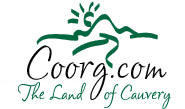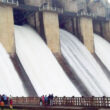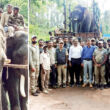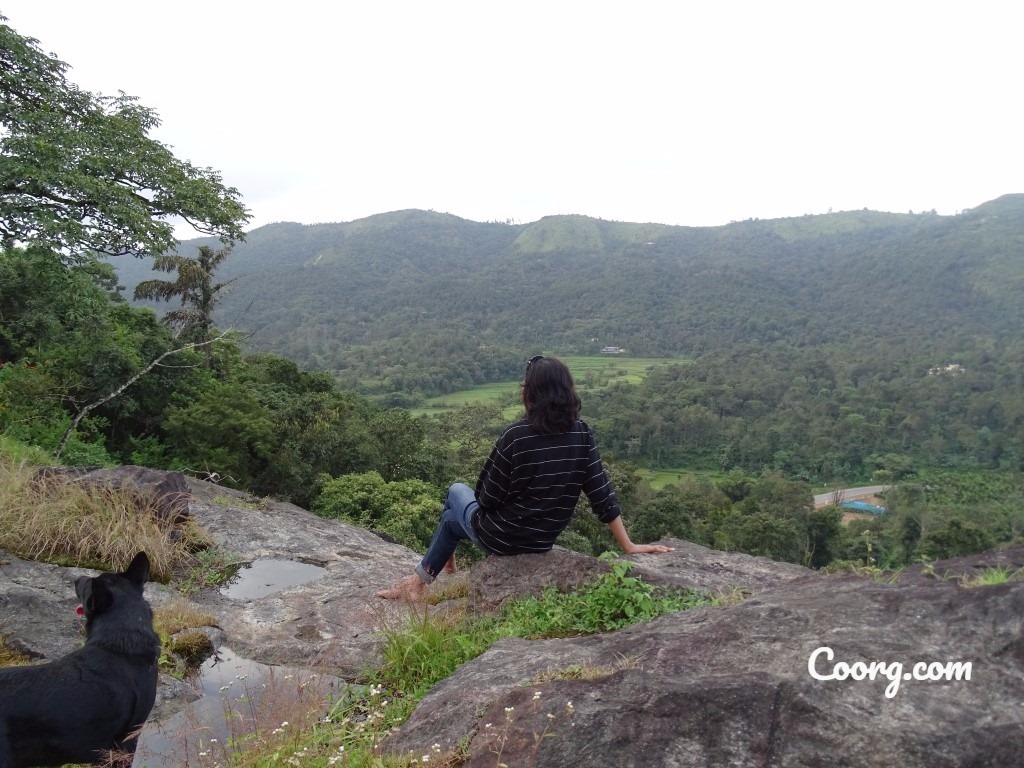THE LAND
Coorg is a landlocked district in the State of Karnataka, officially known as Kodagu. The district is spread across an area of 4,102 square kilometers. Area-wise Coorg is bigger than the State of Goa. Most of the area in Coorg is hilly and covered with forests and plantations. Coffee plantations being the most visible part of Coorg. Only Kushalnagar town and the areas around it is in the plains (flat land), the rest of Coorg is mountainous with hills and valleys crisscrossing the landscape. Coorg has an average elevation of around 3000 to 5000 feet above sea level. Coorg is rich is biodiversity and is a fragile eco-system. Three wildlife sanctuaries and one reserved forest in Coorg are listed as World Heritage Site, by UNESCO .
TOPOGRAPHY
The hilly topography of Coorg is interspersed with grassy downs, paddy fields, sloping glades & gorges & deep valleys across most part of Coorg.

This abundant rainfall has resulted in lush forest growth that is typical of the Western Ghats mountains. A drive through the thoroughfare certainly will reward one with natural scenic beauty of canopies of trees and expansive scenery of the mountains.
The trees are spread widely opening up patches of grassland. Big timber trees like rosewood, Mathi and teak dominate the areas of the forests where the undergrowth is dense and rainfall is high. The areas of the forests that are drier provide a home for the shorter trees like the Flame of the Forest, bamboo, Indian Laburnum and Dindalu.
Almost most of the villages of Coorg are situated deep inside valleys surrounded by mountain ranges.
WILDLIFE & ECOLOGY
Coorg has four main types of vegetation. The Evergreen forests of the north & west and the Moist deciduous and Dry deciduous forests in the central and southern parts of the district and isolated evergreen or Shola forests are found nestled between the folds of the mountain slopes which are covered by grasslands.
It has three wildlife sanctuaries, Brahmagiri Wildlife Sanctuary, Talakaveri Wildlife Sanctuary and Pushpagiri Wildlife Sanctuary and one national park, Nagarahole or Rajiv Gandhi National Park. Among these Pushpagiri is located in the northern part of Coorg and has rare and endangered flora and fauna. In fact it has been designated as one of the important bird areas of the world. The rich Kadamakkal reserve forest is a part of the sanctuary. The name of the sanctuary, Pushpagiri, has been derived from the highest peak in the region. Kumaraparvat is another smaller peak. The sanctuary is surrounded by Bisle reserve forest and Kukke Subramanya forest ranges.
Wildlife Sanctuaries in Coorg
| Sanctuary Name | Area ( Sq kms ) |
Vegetation
|
| Pushpagiri Wildlife Sanctuary |
92.65 km²
|
Evergreen and Semi-Evergreen
|
| Brahmagiri Wildlife Sanctuary |
181.29 km²
|
Evergreen, Semi-Evergreen and Shola
|
| Talacauvery Wildlife Sanctuary |
105.01 km²
|
Tropical Evergreen
|
National Park in Coorg
| Sanctuary Name | Area ( Sq kms ) |
Vegetation
|
| Nagarhole ( Rajiv Gandhi ) National Park |
644 km²
|
Tropical moist deciduous and Tropical dry deciduous
|
The most popular and well known wild life reserve is Nagarahole or Rajiv Gandhi National Park. It is home to the majestic Asiatic elephant and the Royal Bengal Tiger. Nagarhole is a part of the Nilgiri Biosphere Reserve . Once upon a time it used to be the hunting place for the Maharajas of Mysore & the Coorg Kings alike. A portion of the sanctuary lies in Mysore district. Now it is home to two of the most prestigious and important Indian wildlife protection schemes – Project Elephant and Project Tiger.
The Nagarhole National Park gets its name from the Nagara Hole, which in the native language means Serpent River. A backwater lake(Kabani backwaters) was created to the south of Nagarhole National Park with the building of a dam, which also creates the boundary with the Bandipur Tiger Reserve.
Swampy areas known as hadlus are mixed together with the forests. These areas are dominated by green grass and are favorite grazing grounds to the several herbivores, such as the big herds of chital deer. The grass that spouts in the meadow attracts large numbers of gaur and elephants.
Herds of elephants make their way down to the park in the warmer months during the summer, which is a great time to see them inside of their element. In addition to the elephants, more than three hundred different species of birds have been spotted in the park, including rare species such as the Nilgiri Flycatcher, the White-cheeked Barbet and the Blue Face Malkhoa.
A visit to the Nagarahole national park is a must for any wildlife enthusiast. It is home to some of the wildest beasts like Tiger, Leopard, Wild Dog ( Dhole ), Jungle Cat, Striped Hyena and countless Jackals. Herbivores include Gaur, Axis Deer, Sambar, Mouse Deer, Four-horned Antelope, Wild Boar, Crested Porcupine and the Black-naped Hare. One can also witness primates trooping around while engaged in their monkey business. Common Langur and Bonnet Macaque are aplenty here. Other animals which can be spotted here are the Sloth Bear, Pangolin, Giant Squirrel, Flying Squirrel, Giant Fruit Bat and the elusive Slender Loris.
Bird lovers need not go away disappointed. One can find a large number of birds including some rare species found in India. The Yellow Browed Bulbul, Pacific Swallow, Grasshopper Warbler, Orphean Warbler and the Yellow Billed Babbler can all be seen in their magnificent and resplendent form. Many species of owls can be found here. The Short Eared and Oriental Scops Owl can be often seen after nightfall.
25 % of species found in India are present in Coorg. About 310 species of birds have been sighted and documented in Coorg.
The ecology of Coorg is varied and encompasses a wide variety of plant and animal species. Large timber trees such as teak, rosewood and Mathi (Terminalia tomentosa) can be found in dense and moist undergrowth. The drier areas have shorter trees like Dindalu (Anogeissus Latifolia), Flame of the Forest, Indian Laburnum and bamboo.
Coorg which is a part of Western Ghats is an environmental “hot spot” because of its fragile environment. Western Ghats has been included in UNESCO World Heritage Site. 3 Wildlife Sanctuaries – Pushpagiri Wildlife Sanctuary, Brahmagiri Wildlife Sanctuary, Talacauvery Wildlife Sanctuary & 2 Reserve Forests – Padinalknad Reserved Forest & Kerti Reserved Forest, which are located in Coorg are included in the list.*
An awareness program called “Coorg – An Alternative Model” has been initiated to teach the locals about the fragile ecosystem and ways to manage and sustain development without damaging the environment.
The diversity of wildlife, Flora and fauna in Coorg can hardly be matched by any other place in India . The rain drenched forests and mountain ranges provide a unique ecosystem in which many species of birds, animals and plants find sustenance. The variety of animal and plant species is mind boggling and a treat for the wildlife connoisseurs and laymen alike.
*Source: UNESCO World Heritage Site
ECONOMY

Coorg is a rural region and most of its economy is based on forestry, agriculture and plantations. The economy of Coorg is primarily accredited to the production of coffee and additional plantation crops. Rice is among the other crops that are planted in the valleys of Coorg.
The coffee plantations became important to the district of Coorg in the 1900s, located on the sides of hills that are too steep on which to grow rice, while taking full advantage of the shade from the existing forests. These days, coffee is the major cash crop of the town of Coorg. The two most popular types of coffee that are grown in Coorg are Robusta and Arabica.

The mainstay in the economy of the district of Coorg is pepper, coffee and cardamom. Paddy is farmed once per year and the majority of the agriculture in Coorg is fed by rain. Horticultural products such as cardamom, bananas and oranges are inter-planted within the estates of coffee.
The topography of Coorg is well suited for coffee plantations which require high altitude and steep slopes. Indian coffees are noted for their blue color, cleanness of beans and fine liquoring qualities. The coffee produced in Coorg is strong, rich and has a wonderful deep flavor which is sought after by connoisseurs worldwide. Coorg produces some of the worlds best coffee . The varieties most poplar are Arabica and Robusta which come in different sub varieties. Arabica is grown at elevations between 3000 and 6000 feet whereas Robusta is grown at lower elevations. Arabica is characterized by smaller leaves & stem. Its taste is milder and is preferred for export purposes. Arabica is costlier and is generally used for blending. Robusta plants are comparatively larger with broader leaves and thicker stem. It makes for a stronger blend and requires very little maintenance. Arabica matures earlier but Robusta plants have a much lengthier life span when compared to Arabica.

Traditionally Coorg is known for other produce like cardamom, pepper, oranges & honey. A variety of trees like rosewood, teakwood, silver oak, firewood etc., are grown along with coffee. Coorg Cardamom is highly esteemed. Cardamom is the crop that gives the best returns. Cardamom harvesting can take up to five months.
Other crops such as arecanut, ginger, coconut and some spices are also cultivated in Coorg. Another environment friendly activity, which has become quite a contributor to the economy of the district of Coorg, is bee keeping.
52 % of Coffee produced in Karnataka is from Coorg. Around 35 % of Coffee produced in India is from Coorg.
Many of the Coorg population join the Army. One can often see retired Army personnel engaged in all sorts of productive activities in and around Coorg. Coorg has produced some of the most decorated Generals. The economy of Coorg is fueled by servicemen both retired and active.
Tourism has become a major contributor to the economy of Coorg. Eco-tourism like trekking tours and walking tours are a way for travelers to take full advantage of the houses on the plantations that have been converted into homestays.
What began as an experiment in the mid-1990s, when prices for coffee dropped, homestays at the plantation estates have quickly become a way for the people of Coorg to earn a supplemental income.
NATIVE PEOPLE & CULTURE

Coorgs or Kodava people are distinguished from other Indian communities by their unique customs, traditions, beliefs, family structure, food and traditional attire. Because of their customs and traditions, so different then their neighbors, and physical attributes of many Coorgs, their origins has always been questioned by historians and ethnologists. Sir Herbert Risley went as far to describe the Coorgs as the “finest race without any exception in Southern India”. Most agree that, though their male ancestry is questionable, their female ancestry is from the neighboring surroundings of Coorg. They speak Kodava(Coorg) Language which has been influenced by Tulu, Malayalam, Tamil and Kannada languages.

The traditional attire of the Coorg people is unlike any other in India. The men wear coats that hang down to their knees with sleeves that only come down as far as their elbows; a gold and scarlet sash; a gilted turban or a red and white checkered scarf called Mande-tuni, and a silver or gold sheathed ornate dagger with sword called Odi-kathi. Women of Coorg wear their sari in a unique way by tucking in the pleats in the back, typical Indians tuck the pleats in the front.

War & agriculture were their only occupation pre – 1900’s. The martial desires of Coorgs did not subside even when india became independent. Albright their negligible population in comparison to other communities in India, Coorgs joined the Indian Army in hordes.
Even today, each family had at least one member serving in the Indian Armed Forces. Hundreds of ex-servicemen reside in Coorg.

Field Marshal Cariappa, the first Chief of Indian Armed forces, of independent India, belonged to Coorg. Traditionally, at least one member of a Coorg okka(clan) always joins the army.
Coorg is also home to many other community such as Yeravas, Kurubas, Kudiyas, Holeya and Airies. Lingayats, Arebhase Gowdas, Tuluvas, Brahmin, Konkani, Christians, Muslims, Jain, and other immigrant communities from neighboring districts and states also live in Coorg, some have been staying in Coorg since centuries.
CULTURE & TRADITIONS

The Coorg customs are quite different from those of the other people of India. The people of Coorg are well known for being hospitable. A delicacy that is served at community feasts is pork, prepared in vinegar that has been made from a fruit. Pork is the staple meat at any traditional Coorg function.
Weapons & Guns form an integral part of Coorg traditions and religious beliefs. They have a festival completely dedicated to weapons called Kail Podh.
- The Puttari(Huttari) harvest festival is opened up with the firing of guns.
- When a family is blessed with a child, a single gunshot is fired into the sky to announce & mark the arrival of the little one.
- Likewise, when a Coorg(Kodava) passes away, gunshots are fired into the sky to mark the death of the person, the arrival of mourners at a funeral and the departure of the deceased during the cremation.

These customs are still followed in Coorg. Coorgs follow Animism and Hinduism. Primarily, the people of Coorg worship ancestors and River Kaveri(as the mother goddess). Lord Shiva is the chief deity among Kodavas.
Coorgs worship nature and they hold the river Cauvery in the highest regards. To them, the holy river is their mother. It is mentioned in the Puranas that the Coorgs were summoned by Lord Brahma when the River was going to take birth. All the Coorgs gathered at Talacauvery and took the first dip when the Goddess appeared and turned into the river. The people of Coorg are blessed by touching their elders’ feet. A mother is held in the highest regard within the Coorg society. The mother is the first to bless a journeyman or young married couple. A Coorg widow may still participate in joyous occasions such as her children’s weddings. She is seen as the principal figure for conducting wedding ceremonies that are conducted traditionally by elders without the participation of a priest.

It may come as a surprise to many that the Kodava(Coorg) language has no word for dowry and prostitution, both of which are absent among the Coorgs. The general level of culture and education among women of Coorg has always been higher, women know their rights and are treated well in the family. A widow may remarry, which is quite common and has always been acceptable in the Coorg culture.
Even though Coorgs are Hindus, their marriage rights are not performed by a priest. Weddings in Coorg are like something from another planet. The groom claims a bride once a member of his clan has killed mock banana trunk soldiers. Following a feast, the men and women of Coorg get down to dancing, to the tribal beats which have not have changed since time immemorial.

The Coorg family unit is known as the okka(clan). Coorgs are a patrilineal tribe made up of males with common ancestry. The male members of the clan all share a unique clan name. Presently, there are nearly 1000 okka names in Coorg.
The okka members worship the okka founder, known as the Guru Karona.
In the central hall of every home in Coorg, you will find a Nellakki Bolucha, a lamp that is lit to honor the Guru Karona(the first patriarch of the clan). The eldest member of an Okka is traditionally treated as the deity. The Coorgs are also worshipers of nature and revere the earth, moon, fire and sun. The cultures and traditions of the Coorgs embrace Hinduism, but are unique and immensely different. Usually a priest oversees none of their births, deaths, marriages or festivals. Meat and libations are served at most of their feasts.
HISTORY

The majority of the early accounts of Coorg(Kodagu) are fundamentally eminent and the genuine record of history in Coorg is available only following the ninth century. On the word of inscriptions, Coorg was under the rule of many dynasties of South India such as Changalvas, Cholas, Gangas, Hoysalas, Kadambas and Pandyas.
It is believed that early on the northern part of Kodagu was under the Kadambas and the south under the Gangas. The Cholas were a powerful force in the eleventh century they defeated the Gangas. However, the Changalva Arasus continued o rule the south Kodagu when Raja Chola was ruling in Tanjavur.
The northern parts of Kodagu were ruled by the Kongalvas who were a vassal of the Cholas. The situation more or less remained the same till the invasion under Alauddin Khilji. In the fourteenth century the Changalvas became prominent rulers of Kodagu. For most of the period the influence of the Changalvas or the Kongalvas never reached beyond the borders of Kodagu.
The period between the eleventh and sixteenth centuries were tumultuous and rulers changed faster than the seasons. However, Kodagu continued to cling on to its independent stature. The fall of the Vijayanagara empire signaled a change and in this period A monk connected to Keladi Nayaks of Ikkeri took over Kodagu and established the Paleri(Haleri) Kingdom. Paleri kings, who were Lingayats of Veerashaiva faith, ruled the region for more than 200 years (1580 – 1834). The first ruler of Paleri dynasty was Vira Raja. His grandson Muddu Raja I was a popular ruler and ruled for more than 50 years. He moved his headquarters to current day Madikeri in 1681. It was called Muddu Raja Keri and later shortened to Madikeri. Under the Paleri dynasty Kodagu attained a status as an Independent kingdom. Dodda Virappa ruled from 1687 – 1736. Under his rule the administration of the region was streamlined into villages and districts. Other notable figures in the history of Kodagu are Dodda Vira Rajendra (1780 – 1809) and Linga Raja II (1811 – 1820).
After taking over Mysore kingdom, Hyder Ali contested the territories of Coorg. The Coorg King Chikka Virappa agreed to part with certain territories captured in the previous wars with the Mysore Kingdom. Matters escalated into war. In 1765 Lingaraja I, the younger brother of the Haleri King Muddayya attacked Hyder’s troops near the boundary with Mysore and Ali relented. More wars ensued till 1768 and the Mysore Army was defeated in their stronghold near Coorg borders. Hyder relented, a treaty was effected and the boundaries of Mysore and Coorg, fixed.
Once again, due to internal squabbling among the ruling kings, Linga Raja I escaped Coorg and asked Hyder Ali for his assistance to capture Coorg from his Horamale cousins who had taken control of Coorg. Hyder sided with Linga Raja I and succeeded in installing him on the throne with the help of disgruntled Coorgs, who helped Hyder’s army in the attack on Madikeri. After the takeover Hyder reduced Linga raja I to vassalage. The takeover was detested by the Coorgs by sporadic rebellions. Lingaraja I died in 1780, leaving behind his three sons to claim the throne. But Hyder Ali took control of Coorg and installed his governor to rule over Coorg on the pretext that the children were too young to sit on the throne. Hyder Ali’s direct control over Coorg enraged the Coorgs and the war that broke out in June, 1782 was very successful and the Kodavas drove out Hyder’s troops and administrators, with Madikeri being the only territory in the hands of Mysoreans.
Hyder Ali sent his commanders with forces to subdue the Coorgs, they captured the minor princes and sent them to reside at Periapatna Fort. These developments further enraged the Coorgs and Madikeri soon fell. Hyder Ali died in 1782 and his son Tipu Sultan took over. After his victory against the British at Mangalore, Tipu Sultan marched through Coorg with his whole army and defeated the Coorgs. He retained control of Coorg and strengthened the garrison at Mercara Fort. He called a meeting of Coorg chiefs and delivered to their hands written mandate accusing them of polyandry, massacring his armies & rebelling against Hyder seven times. He left Coorg after warning the Kodavas with forcible conversion and banishment, if they would rebel again. Enraged, the Kodavas again rose up in rebellion, sacked and plundered Madikeri.
In 1784 Tippu entered Coorg with a 32,000 strong army, along with a French battalion commanded by General Monsieur Lally and defeated the Coorg Army, made true of his threat and hauled thousands of civilian Coorgs to Srirangapatna.
In 1788, Coorgs rescued their king Dodda Vira Rajendra, the eldest of the princes, who had been taken prisoner by Tipu and held in Periyapatna fort. The Coorgs who escaped Tipu’s army, rallied around the the young Prince and kept engaging Tippu’s forces in the battlefield. By 1790 Dodda Vira Rajendra had successfully attacked and sacked most of the forts in Coorg, garrisoned by Tipu Sultan’s forces.
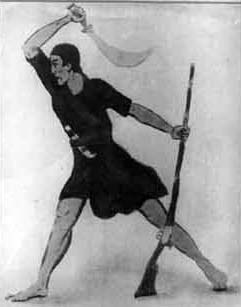
The same year Dodda Vira Rajendra came in contact with the British. In October 26, 1790 Dodda Vira Rajendra signed a treaty of “friendship” with the EIC, to treat Tipu Sultan as a common enemy with the British – with the “God, sun, moon and world” as witness. In 1791, after a prolonged siege, Tipu’s forces evacuated Mercara(Madikeri) Fort and Dodda Vira Rajendra regained his entire kingdom. The Kodavas helped the British with transport and safe passage from Coorg during the Third Anglo Mysore war.
By 1793, the Kodavas upped the ante and captured more territories outside Coorg, made sure that Tipu’s army cannot set foot in Coorg and openly attacked & looted some of Tipu’s territory to cause him trouble.
Eventually, the Kodavas backed and fought along the British troops during the 4th Anglo Mysore War. Tipu Sultan’s first attempt during the final battle was to storm Coorg with his best Generals & Troops and defeat the Kodavas & British troops who have entered Coorg. The attempt was a complete disaster. Some of Tipu’s best Generals were killed in the battle near Kushalnagar. Tipu sultan retreated to Srirangapatna with his remaining army, where he has killed.
Coorg was able maintain its Independence till 1834. During which time the differences developed between the Coorg kingdom and the EIC Officials at Mysore. It finally led to war. Some from the King’s nobility switched sides and escorted the British troops to the seat of the government. Unlike his predecessors the last king was not leading the troops and a cease-fire was called by the King, when he knew that Madikeri has fallen into British hands. The Kingdom was annexed by the British and the last King, Chikka Veera Rajendra, with his family were exiled to Benaras.
Following Coorg’s British annexation in the early 1834, the region was directly under British rule until the Indian Independence in the late 1947. Later, Coorg was recognized by the Indian Constitution as part “C” state and elected a government to assume office till 1956 with a chief minister of its own.
In November of 1956, the the State of Coorg was amalgamated with the onetime state of Mysore, as part of a state reorganization. Now, the district of Coorg(Kodagu) is part of the state of Karnataka.
Throughout the history of Coorg, no ruler has held direct sway over the region. Coorg has always been under the influence of local chieftains. The culture of Coorg has never been assimilated with the neighbors and has always maintained their unique identity.
